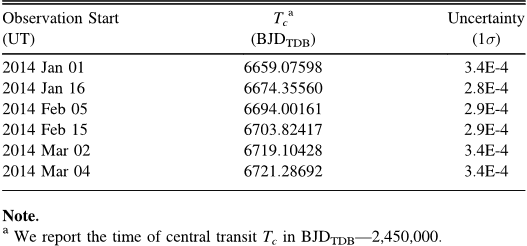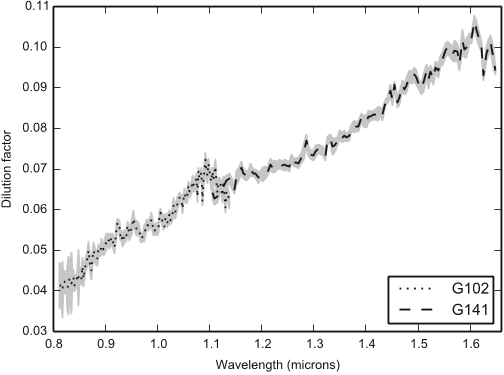A Detection of Water in the Transmission Spectrum of the Hot Jupiter WASP-12b and Implications for its Atmospheric Composition
Laura Kreidberg,Michael R. Line,Jacob L. Bean,Kevin B. Stevenson,Jean-Michel Desert,Nikku Madhusudhan,Jonathan J. Fortney,Joanna K. Barstow,Gregory W. Henry,Michael H. Williamson,Adam P. Showman +10 more
Reads0
Chats0
TLDR
In this article, a near-infrared transmission spectrum for WASP-12b based on six transit observations with the Hubble Space Telescope/Wide Field Camera 3 (HST-WFC) was reported.Abstract:
Detailed characterization of exoplanets has begun to yield measurements of their atmospheric properties that constrain the planets’ origins and evolution. For example, past observations of the dayside emission spectrum of the hot Jupiter WASP-12b indicated that its atmosphere has a high carbon-tooxygen ratio (C/O > 1), suggesting it had a dierent formation pathway than is commonly assumed for giant planets. Here we report a precise near-infrared transmission spectrum for WASP-12b based on six transit observations with the Hubble Space Telescope/Wide Field Camera 3. We bin the data in 13 spectrophotometric light curves from 0.84 - 1.67 m and measure the transit depths to a median precision of 51 ppm. We retrieve the atmospheric properties using the transmission spectrum and nd strong evidence for water absorption (7 condence). This detection marks the rst high-condence, spectroscopic identication of a molecule in the atmosphere of WASP-12b. The retrieved 1 water volume mixing ratio is between 10 5 10 2 , which is consistent with C/O > 1 to within 2 . However, we also introduce a new retrieval parameterization that ts for C/O and metallicity under the assumption of chemical equilibrium. With this approach, we constrain C/O to 0:5 +0:2 0:3 at 1 and rule out a carbon-rich atmosphere composition (C/O> 1) at > 3 condence. Further observations and modeling of the planet’s global thermal structure and dynamics would aid in resolving the tension between our inferred C/O and previous constraints. Our ndings highlight the importance of obtaining high-precision data with multiple observing techniques in order to obtain robust constraints on the chemistry and physics of exoplanet atmospheres. Subject headings: planets and satellites: atmospheres | planets and satellites: composition | planets and satellites: individual: WASP-12bread more
Figures

Table 2 Transit Times 
Figure 6. Systematics decorrelation parameters from the light curve fits plotted as a function of normalization c. We show (from top to bottom) the visit-long slope v, ramp rate constant a, ramp amplitude b, and ramp delay d. The normalization constant c is linearly proportional to the per-pixel flux in a spectroscopic channel. Measurements from the G102 and G141 data are shown in light and dark gray, respectively. The error bars indicate 1σ uncertainties from an MCMC fit to the light curves using the analytic model for instrument systematics. 
Figure 7. Dilution factor αComp, determined from the ratio of flux from WASP12 BC to WASP-12 A. The median dilution (over the 10 staring mode observations) is shown with black lines (dotted for G102 and dashed for G141). The gray shaded region indicates 1σ uncertainty, determined from the median absolute deviation. To calculate the dilution and uncertainty, we interpolate the spectra from each grism onto a common wavelength scale. 
Figure 12. Retrieval results from the C-C parameterization. The left and middle panels show the marginalized distribution for C/O and metallicity. The right panel shows the median (black lines) and 1σ range (shaded regions) of 1000 randomly sampled temperature–pressure profiles for each scenario. Yellow, blue, and red shading correspond to constraints from the fiducial scenario (an uninformative prior on C/O), the oxygen-rich scenario (C/O < 1), and a carbon-rich scenario (C/O > 1). The distribution of C/O values for the carbon-rich model is normalized to have a probability mass of unity over the plotted range; however, the distribution has an extended tail toward higher C/O values that is not shown. 
Table 1 Summary of Photometric Observations for WASP-12 
Figure 1. Raw HST/WFC3 images taken with the G102 grism. Spatial scan and staring mode data are shown in the top and bottom panels, respectively. The images are cutouts from a 256 × 256 pixel subarray. The spectrum of WASP-12A’s binary companion is visible in the bottom panel near row 10.
Citations
More filters
Journal ArticleDOI
The Water Abundance of the Directly Imaged Substellar Companion {\kappa} And b Retrieved from a Near Infrared Spectrum
Kamen O. Todorov,Michael R. Line,Jaime E. Pineda,Michael Meyer,Sascha P. Quanz,Sasha Hinkley,Jonathan J. Fortney +6 more
TL;DR: In this article, a near-infrared spectrum of a substellar companion to a young B9 star was used to estimate the abundances of water vapor and its uncertainty, and an upper limit on the abundance of CH$_4$.
Journal ArticleDOI
C/O and O/H Ratios Suggest Some Hot Jupiters Originate Beyond the Snow Line
TL;DR: In this article, the measured planetary and stellar abundances of carbon and oxygen for ten systems with hot Jupiters were compared against their host stars, and it was shown that a sizable fraction of hot Jupsiters will show enrichment of C/O and lower O/H than their hosts, similar to HD 209458b.
Journal ArticleDOI
Transmission Spectroscopy of WASP-79b from 0.6 to 5.0 μm
K. S. Sotzen,K. S. Sotzen,Kevin B. Stevenson,Kevin B. Stevenson,David K. Sing,Brian M. Kilpatrick,Hannah R. Wakeford,Joseph C. Filippazzo,Nikole K. Lewis,Sarah M. Hörst,Sarah M. Hörst,Mercedes López-Morales,Gregory W. Henry,Lars A. Buchhave,David Ehrenreich,Jonathan Fraine,Antonio García Muñoz,Rahul Jayaraman,Panayotis Lavvas,Alain Lecavelier des Etangs,Mark S. Marley,Nikolay Nikolov,Alexander D. Rathcke,Jorge Sanz-Forcada +23 more
Journal ArticleDOI
The Hubble Space Telescope PanCET Program : An Optical to Infrared Transmission Spectrum of HAT-P-32Ab
Munazza Alam,Mercedes Lopez-Morales,Nikolay Nikolov,David K. Sing,Gregory W. Henry,Claire Baxter,Jean-Michel Desert,Joanna K. Barstow,Thomas Mikal-Evans,Vincent Bourrier,Panayotis Lavvas,Hannah R. Wakeford,Michael H. Williamson,Jorge Sanz-Forcada,Lars A. Buchhave,Ofer Cohen,Antonio García Muñoz +16 more
TL;DR: In this paper, the authors presented a 0.3-5 μm transmission spectrum of the hot Jupiter HAT-P-32Ab observed with the Space Telescope Imaging Spectrograph and Wide Field Camera 3 instruments mounted on the Hubble Space Telescope, combined with Spitzer Infrared Array Camera photometry.
Journal ArticleDOI
Retrieval Analysis of the Emission Spectrum of WASP-12b: Sensitivity of Outcomes to Prior Assumptions and Implications for Formation History
Maria Oreshenko,Baptiste Lavie,Baptiste Lavie,Simon L. Grimm,Shang-Min Tsai,Matej Malik,Brice-Olivier Demory,Christoph Mordasini,Yann Alibert,Willy Benz,Sascha P. Quanz,Roberto Trotta,Kevin Heng +12 more
TL;DR: In this paper, the emission spectrum of the hot Jupiter WASP-12b was analyzed using the HELIOS-R retrieval code and the HeliOS-K opacity calculator.
References
More filters
Journal ArticleDOI
emcee: The MCMC Hammer
TL;DR: The emcee algorithm as mentioned in this paper is a Python implementation of the affine-invariant ensemble sampler for Markov chain Monte Carlo (MCMC) proposed by Goodman & Weare (2010).
Journal ArticleDOI
The Chemical Composition of the Sun
TL;DR: The solar chemical composition is an important ingredient in our understanding of the formation, structure, and evolution of both the Sun and our Solar System as discussed by the authors, and it is an essential refer...
Journal ArticleDOI
emcee: The MCMC Hammer
TL;DR: This document introduces a stable, well tested Python implementation of the affine-invariant ensemble sampler for Markov chain Monte Carlo (MCMC) proposed by Goodman & Weare (2010).
Journal ArticleDOI
Analytic Lightcurves for Planetary Transit Searches
Kaisey S. Mandel,Eric Agol +1 more
TL;DR: In this paper, exact analytic formulae for the eclipse of a star described by quadratic or nonlinear limb darkening are presented for the HST observations of HD 209458, showing that the ratio of the planetary to stellar radii is 0.1207+-0.0003.
Journal ArticleDOI
Analytic Light Curves for Planetary Transit Searches
Kaisey S. Mandel,Eric Agol +1 more
TL;DR: In this paper, the exact analytic formulae for the eclipse of a star described by quadratic or nonlinear limb darkening were presented, and the authors applied these results to the Hubble Space Telescope observations of HD 209458, showing that the ratio of the planetary to stellar radii is 0.1207 ± 0.0003.
Related Papers (5)
A continuum from clear to cloudy hot-Jupiter exoplanets without primordial water depletion
David K. Sing,Jonathan J. Fortney,Nikolay Nikolov,Hannah R. Wakeford,Tiffany Kataria,Thomas M. Evans,Suzanne Aigrain,Gilda E. Ballester,Adam Burrows,Drake Deming,Jean-Michel Desert,Neale P. Gibson,Gregory W. Henry,Catherine M. Huitson,Heather Knutson,Alain Lecavelier des Etangs,Frederic Pont,Adam P. Showman,Alfred Vidal-Madjar,Michael H. Williamson,Paul Wilson +20 more
INFRARED TRANSMISSION SPECTROSCOPY OF THE EXOPLANETS HD 209458b AND XO-1b USING THE WIDE FIELD CAMERA-3 ON THE HUBBLE SPACE TELESCOPE
Drake Deming,Drake Deming,A. Wilkins,Peter R. McCullough,Adam Burrows,Jonathan J. Fortney,Eric Agol,Eric Agol,Ian Dobbs-Dixon,Ian Dobbs-Dixon,Nikku Madhusudhan,Nicolas Crouzet,Jean-Michel Desert,Ronald L. Gilliland,Korey Haynes,Korey Haynes,Heather Knutson,Michael R. Line,Zazralt Magic,Avi Mandell,Sukrit Ranjan,David Charbonneau,Mark Clampin,Sara Seager,Adam P. Showman +24 more
Infrared Transmission Spectroscopy of the Exoplanets HD209458b and XO-1b Using the Wide Field Camera-3 on the Hubble Space Telescope
Drake Deming,Ashlee Wilkins,Peter R. McCullough,Adam Burrows,Jonathan J. Fortney,Eric Agol,Ian Dobbs-Dixon,Nikku Madhusudhan,Nicolas Crouzet,Jean-Michel Desert,Ronald L. Gilliland,Korey Haynes,Heather Knutson,Michael R. Line,Zazralt Magic,Avi Mandell,Sukrit Ranjan,David Charbonneau,Mark Clampin,Sara Seager,Adam P. Showman +20 more